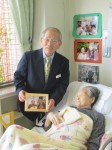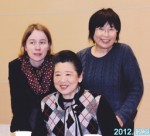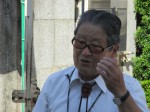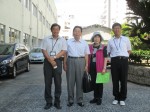Interviewees from Hiroshima 2014
‘We live in an era of the witness’, wrote Annette Wienorka in her 2006 book, The Era of the Witness. I recently gave a talk on witnessing the survivors of Hiroshima for the English department of the Open University Post Graduate Research conference held on 22 November 2014 at the OU’s Camden Centre. I spent the last part of my travel grant, provided by the Great British Sasakawa Foundation, on a trip to Hiroshima in September this year. During this trip I interviewed about a dozen witnesses — known as hibakusha in Japanese — as well as those who work with or study the history of the hibakusha, (from hibaku, explosion, and sha, person, in Japanese).
The witnesses of Hiroshima about whom I am writing for my PhD will be placed under the spotlight in August 2015, which will see both the 70th anniversary of the end of the World War Two and of the dropping of the atomic bombs on Hiroshima and Nagasaki on 6th and 9th August 1945. One of the questions I have for my thesis is how to situate the role of the witness in Hiroshima, alongside other sites of witnessing?
As Jovan Byford wrote in his chapter ‘Testimony’ in Research Methods for Memory Studies, edited by E. Keightley and M. Pickering (2013), narratives of witnesses are now an indispensable part of the representation of holocausts. Indeed, even survivors of other, more mundane disasters, including traffic accidents, rapes or attempted murders, are seen as the voice of moral authority. In museums around the world, audio-visual recordings made by survivors mean we can accompany them on a journey into the past, giving us the sense that in some way ‘we were there’ with the survivors.
Many of the survivors I interviewed are qualified as official witnesses to the atomic bombing, shogensha in Japanese, and work as volunteer guides in the Hiroshima Peace Memoriam museum. In Hiroshima, becoming a shogensha can take up to two years, since there is a strict set of criteria for those who are allowed to call themselves hibakusha. Once qualified, the hibakusha, whose average age is now 79, are invited to speak in schools all over Japan.
There is currently an official drive to collect and archive as many experiences of survivors as possible, amid considerations of how to pass on the experience to the next generation. But this is simply to scratch the surface of the issue of how to convey the experiences of the hibakusha. A features editor who works for one of the oldest newspapers in the region, the Chugoku Shimbun, which has published survivors’ stories for the past seven decades, told me many of those who have been interviewed still do not want to let their loved ones know they are speaking out.
There are historical reasons for this. As with the Jewish holocaust, not many survivors of the atomic bomb spoke about their experience in the immediate aftermath of the event, and those who did went against the wishes of the authorities. After the war, Japan was occupied by the US and Allied Forces, under the command of General Douglas MacArthur. The censorship imposed by Americans decreed that ‘anything not factual must not be reported because it is prejudicial to the armed forces’. General Macarthur oversaw censorship in the press, especially when it came to the discussion of the effects of the atomic bombs. Foreign and Japanese journalists, writers and poets were censored.

102-year-old witness of Hiroshima with Dr Nanao Kamada, the director of the Nozomien nursing home for atomic bomb survivors in Hiroshima
I interviewed a local historian of Hiroshima who told me he thinks most hibakusha died without speaking publicly about their experience of the bombing: ‘Very soon after the atomic bomb, there was talk about how Hiroshima had been transformed into a city of peace, “in a flash”,’ he said.
Was this an official policy?
‘Well, no one knows – you see nothing was written down at that time because censorship, known as the press code,was in place at that time. By the time the press code was lifted [in 1949] the narrative was already in place. People had lost entire families, although the authorities were already talking about the city as a city of peace you see.’
Many hibakusha have spoken since then, especially after nuclear testing began in the Pacific in the 1950s, but during the Cold War period victims’ stories were used for political and partisan ends, which heightened the unease that hibakusha felt about sharing their experiences. The term ‘trauma’ was not embraced to such an extent as it was among the Jewish holocaust survivors.
The same features editor says there are other issues about handing down the hibakusha experiences in English and in Japanese. ‘Many hibakusha can be viewed as just like your average grandmother or grandfather, so the younger generation would not think of asking them about their experiences in the war. They are just like normal people; they ask their grandchildren whether or not they have a boyfriend!’ She heads a project for the Chugoku Shimbun to get third generation survivors (the grandchildren of hibakusha), to participate in a project to interview the first generation, as a way of educating them about their parents’ and grandparents’ lives and transmitting the experience of the atomic bombings .
I interviewed one of the participants in this project, a third-generation hibakusha, named Masataka Tanaka, a 19-year-old university student in Hiroshima. As a child growing up in Hiroshima, Tanaka would have been educated quite thoroughly about the effects of the atomic bombing at school. He was brought up mainly by his grandmother, who was a hibakusha and lived in his family home, but she had never told him her full experience until he interviewed her for the Chugoku Shimbun. He was shocked and surprised by what she told him, and her story inspired him to study disarmament issues within legal studies at university after she died.
In this way, witnessing in Hiroshima is transmitted across the generations – a live issue for the children, grandchildren and great-grandchildren who have succeeded the survivors of the atomic bomb.
See also my earlier post: Towards an oral history of Hiroshima



